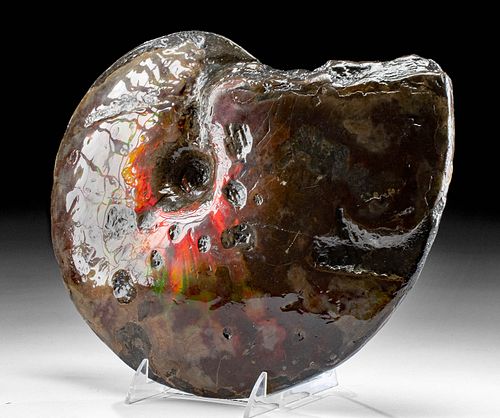Fossilized Ammolite Ammonite w/ Mosasaur Bitemark
Lot 127
About Seller
Artemis Fine Arts
686 S Taylor Ave, Ste 106
Louisville, CO 80027
United States
Selling antiquities, ancient and ethnographic art online since 1993, Artemis Gallery specializes in Classical Antiquities (Egyptian, Greek, Roman, Near Eastern), Asian, Pre-Columbian, African / Tribal / Oceanographic art. Our extensive inventory includes pottery, stone, metal, wood, glass and textil...Read more
Estimate:
$7,000 - $9,000
Absentee vs Live bid
Two ways to bid:
- Leave a max absentee bid and the platform will bid on your behalf up to your maximum bid during the live auction.
- Bid live during the auction and your bids will be submitted real-time to the auctioneer.
Bid Increments
| Price | Bid Increment |
|---|---|
| $0 | $25 |
| $300 | $50 |
| $1,000 | $100 |
| $2,000 | $250 |
| $5,000 | $500 |
| $10,000 | $1,000 |
| $20,000 | $2,500 |
| $50,000 | $5,000 |
| $100,000 | $10,000 |
| $200,000 | $20,000 |
About Auction
By Artemis Fine Arts
Mar 24, 2022
Set Reminder
2022-03-24 10:00:00
2022-03-24 10:00:00
America/New_York
Bidsquare
Bidsquare : Exceptional Antiquities Ethnographic Fine Art
https://www.bidsquare.com/auctions/artemis-gallery/exceptional-antiquities-ethnographic-fine-art-9057
Museum-worthy examples of classical antiquities (Egyptian, Greek, Roman, Near Eastern), Viking, Far East / Asian, Pre-Columbian, African / Tribal, Oceanic, Native American, Spanish Colonial, Fossils, Ancient Jewelry, Fine / Visual Arts, so much more! Artemis Fine Arts info@artemisfinearts.com
Museum-worthy examples of classical antiquities (Egyptian, Greek, Roman, Near Eastern), Viking, Far East / Asian, Pre-Columbian, African / Tribal, Oceanic, Native American, Spanish Colonial, Fossils, Ancient Jewelry, Fine / Visual Arts, so much more! Artemis Fine Arts info@artemisfinearts.com
- Lot Description
North America, Canada, Alberta, Bearpaw formation, late Cretaceous, ca. 71 million years ago. This is a breathtaking ammonite of the Placenticerus costatum genus, with an iridescent ammolite shell and puncture marks from a mosasaur! Not only is this ammonite astounding for the preserved signs of predation, but this shell also has turned into ammolite, a stunning organic gemstone that boasts an astonishing array of rainbows colors. Here, the brightness of this specimen's colors and the iridescence is a testament to the well-preserved state of the nacreous shell, and glimmers in fiery hues of red and orange. The color play due to lighting on this piece is astounding- best seen in person! Ammonite shells provided much needed protection from most predators, but a sizable and hungry mosasaur (an extinct marine reptile) could probably crush the shell in its jaws to get at the soft tissue. Size: 12.5" L x 2.75" W x 10" H (31.8 cm x 7 cm x 25.4 cm)
The puncture holes seen on this shell- the circles near the recessed spiral- are likely teeth marks from mosasaurs, although there is some debate whether the marks are a result from limpets attaching themselves to the ammonites; however, their size as well as presence on both sides of the ammonite, linked them to the upper and lower jaws and the bite of medium-sized Mosasaurs. Another interesting note is the remains of what appears to be the tips of fossilized tentacles or other organic tissue material on the chamber opening!
Ammolite is a rare, iridescent, gem-quality material cut from the fossilized shells of extinct sea creatures known as ammonites. Found only in the Bearpaw Formation in Alberta, Canada - along the eastern slopes of the Rocky Mountains - this organic gemstone has a dazzling range of colors and patterns and is highly desired for freeform natural cabochons and assembled jewelry pieces.
According to the International Gem Society (IGS) statement on the difference between Ammolite and Ammonite: "You may find the terms ammolite and ammonite sometimes used interchangeably. However, ammonite, strictly speaking, refers to the fossil shells of ammonites, whether gem-quality or not. Ammolite refers to the gem-quality material made from fossils of particular species of ammonites." Also, according to IGS, "Ammonites were marine mollusks that became extinct around 65 million years ago. There were many species of ammonites, and their fossils have been found across the globe. The fossils of Placenticeras meeki, Placenticeras intercalare, and Baculites compressus can yield gem-quality ammolite. To date, this material has been found only in Alberta, Canada."
Provenance: ex-private Wildwood, Missouri, USA collection
All items legal to buy/sell under U.S. Statute covering cultural patrimony Code 2600, CHAPTER 14, and are guaranteed to be as described or your money back.
A Certificate of Authenticity will accompany all winning bids.
PLEASE NOTE: Due to recent increases of shipments being seized by Australian & German customs (even for items with pre-UNESCO provenance), we will no longer ship most antiquities and ancient Chinese art to Australia & Germany. For categories of items that are acceptable to ship to Australia or Germany, please contact us directly or work with your local customs brokerage firm.
Display stands not described as included/custom in the item description are for photography purposes only and will not be included with the item upon shipping.
#170127Professionally prepared with a clear fixative on surface to protect the shell. Mosasaur puncture holes and old gouges and abrasion to both sides likely from predation activity, and shell material is missing to that area. Stable fissures from fossilization throughout. Gorgeous iridescence!Condition
- Shipping Info
-
All shipping is handled in-house for your convenience. Your invoice from Artemis Gallery will include shipping calculation instructions. If in doubt, please inquire BEFORE bidding for estimated shipping costs for individual items.
-
- Buyer's Premium



 EUR
EUR CAD
CAD AUD
AUD GBP
GBP MXN
MXN HKD
HKD CNY
CNY MYR
MYR SEK
SEK SGD
SGD CHF
CHF THB
THB














